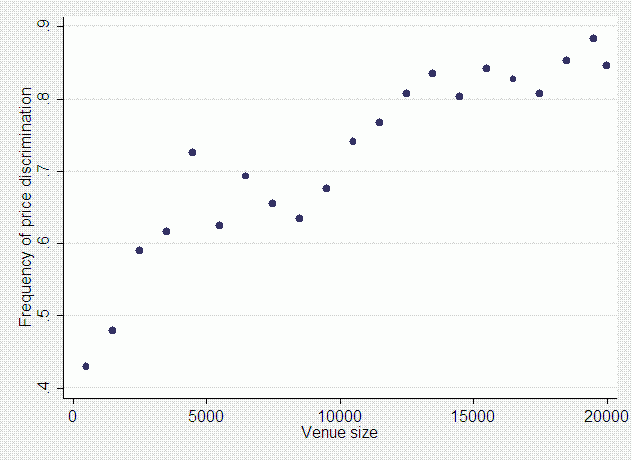When performing artists hit the road on tour, they have a very good reason for putting up with life away from home and gruelling schedules – performing for local audiences is profitable. In 1997-1998, the not-so-young Rolling Stones travelled 25 countries with their Bridges to Babylon Tour, performing 108 shows in front of 4 million people and earning over $100 million in revenue. Connolly and Krueger (2006) point out that the majority of pop artists earn most of their income from concert tours, and concert prices increased throughout the 90’s, along with artist revenues.
Interestingly, performers have begun looking for new strategies for pricing tickets. In the 1970s, single-price ticketing was the norm. Today, it is more common for tickets to be sold at different prices reflecting a variety of seating categories. Economists call this practice price discrimination and see it as mainly a means of increasing revenue. But does it increase revenue and, if so, by how much? We recently researched these questions using data from about 21,000 concerts by the top 100 grossing artists over the period 1992-2005 (Courty and Pagliero 2009).
How much can an artist earn through price discrimination?
About 25% of the concerts in our sample do not rely on price discrimination and sell all tickets to an event at the same price. About half of the concerts split the venue into two ticket categories, and the others use three or four categories. We find that offering multiple seating categories leads to revenues that are approximately 5% higher than single-price ticketing. In addition, the return to price discrimination is higher in markets where the public is more heterogeneous in age, occupation, or ethnicity. In such markets, some consumers are always willing to pay more for quality, and artists can take advantage of this by charging more for the best seats.
Figure 1. The estimated increase in revenue from additional seating categories
The last characteristic we studied is how revenues change when the number of seating categories increases. Figure 1 displays the return from adding seating categories and shows that the incremental return is decreasing with the number of categories. The important point, however, is that adding categories can substantially increase profits. It is puzzling that only a very small fraction of the concerts in our sample use three or four categories. Adding a third category would increase the revenues of the average concert in our sample by about $15,000 and adding a fourth one by $10,000. It is also perplexing that none of the artists in the sample has experimented with more than four categories, although we know that opera houses, for example, often use more than four categories. It is not clear what factors contribute to this limit in the number of seating categories at pop music concerts.
Why do older artists and artists performing in larger venues price discriminate?
Figure 2 shows that artists performing in larger venues are more likely to price discriminate. One interpretation for this is as follows. Price discrimination is more profitable when seats in different categories offer very different experiences. If all the seats provided essentially the same experience, artists would have no way of justifying the differences in price, and no consumer would buy the expensive tickets. Larger venues such as arenas offer a greater range of seating quality. The use of price discrimination is expected to increase accordingly.
Figure 2. The frequency of price discrimination by venue size
Note: Venue size is reported on the horizontal axis. Data are grouped by venue size, intervals of 1,000 seats up to 19,000; then 20,000 and larger.
Figure 3 shows that older artists are more likely to price discriminate than their younger peers. Older artists perform in front of more diverse audiences. Young artists, singing to young crowds, acquire a fan base that then follows them throughout their career. Over time, the artist’s audience grows wealthier, and their variability in earnings also increases. In addition, young artists generally do not appeal to older generations, while older artists can appeal to young and old alike. Consider, for example, the continuing success of performers such as The Rolling Stones, Bonnie Raitt, and Bob Dylan. These artists belong to the musical genre known as “nostalgia rock” or “adult-oriented rock”. Older artists are more likely to play for a heterogeneous audience and take advantage of this fact by offering more seating categories.
Figure 3. Frequency of price discrimination by age of the main artist
Note: Age of the artist is reported on the horizontal axis. Concerts with artists younger than 23 are grouped into one category.
Policy relevance
The introduction of price discrimination in the concert industry has far-reaching consequences. From a welfare point of view, price discrimination implies a net transfer of surplus from consumers to producers (box office revenues increase), although there is also an increase in consumer surplus due to a more efficient allocation of seats (those consumers who are willing to pay more for quality seats do, in fact, get the best seats), so the net effect on consumers is ambiguous. Price discrimination also changes the nature of consumers’ experiences. Under general admission in the 1970s, concert-going was democratic. Nowadays, audiences are more likely to be segregated, and the rich and poor are less likely to cross paths. One may also argue that price discrimination could increase concert supply because artists can earn more per concert.
Another consequence of price discrimination is that it takes away profit opportunities from brokers and scalpers. Under assigned seating with a single price category, brokers earn profits by arbitraging the market, buying high quality seats and reselling them at a premium. Our findings show that by splitting the venue even into just a few categories, revenues can increase substantially. Without price discrimination, brokers would capture much of this revenue. With it, brokers are still left with some opportunity for arbitrage (since quality is still un-priced within a section), but the return on these opportunities decreases with the number of seating categories.
References
Connolly, Marie and Alan B. Kruger (2006), Rockonomics: The Economics of Popular Music. Handbook of the Economics of Art and Culture.
Courty, Pascal and Mario Pagliero (2009). The Impact of price discrimination on revenue: Evidence from the concert industry CEPR Discussion Paper 7120.
Courty, Pascal and Mario Pagliero (2009). Price discrimination in the concert industry. CEPR Discussion Paper 7143.





